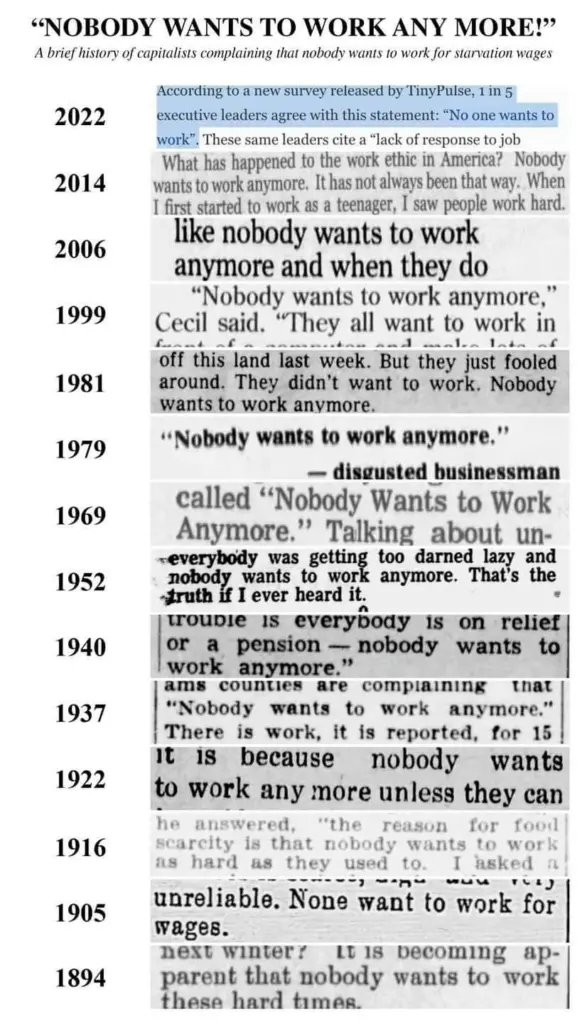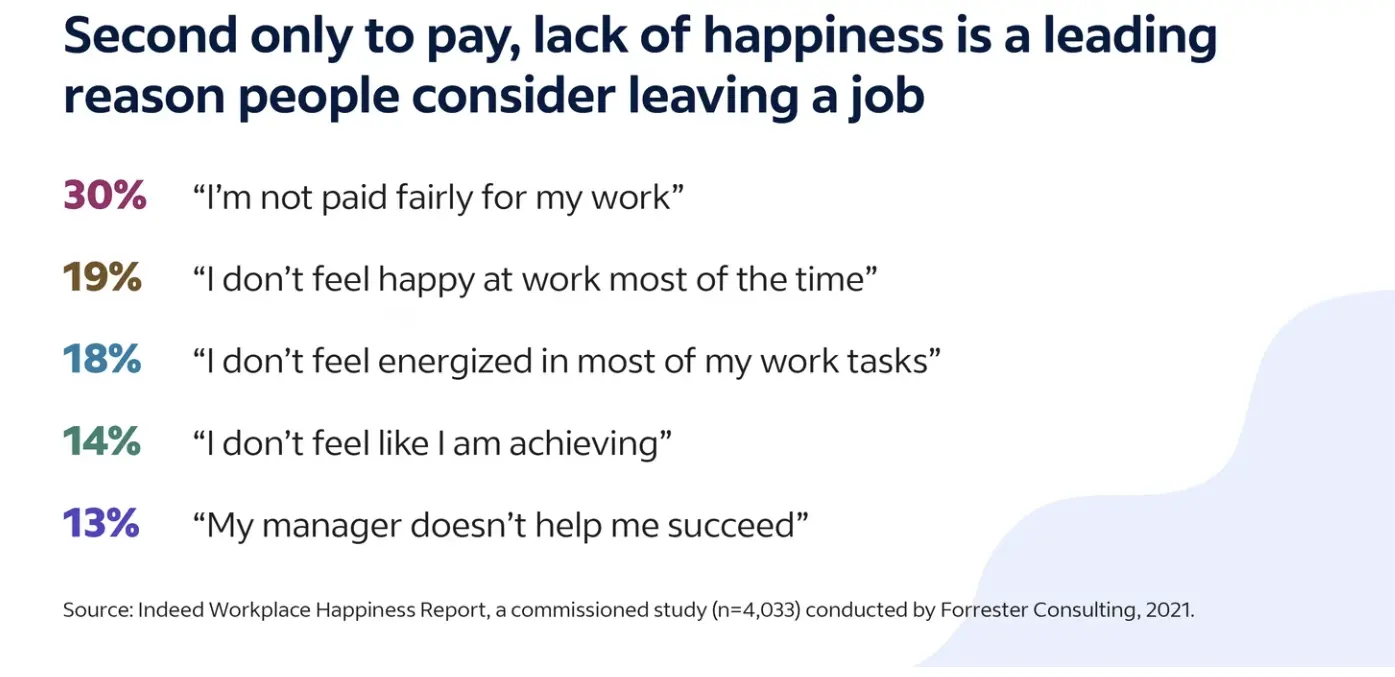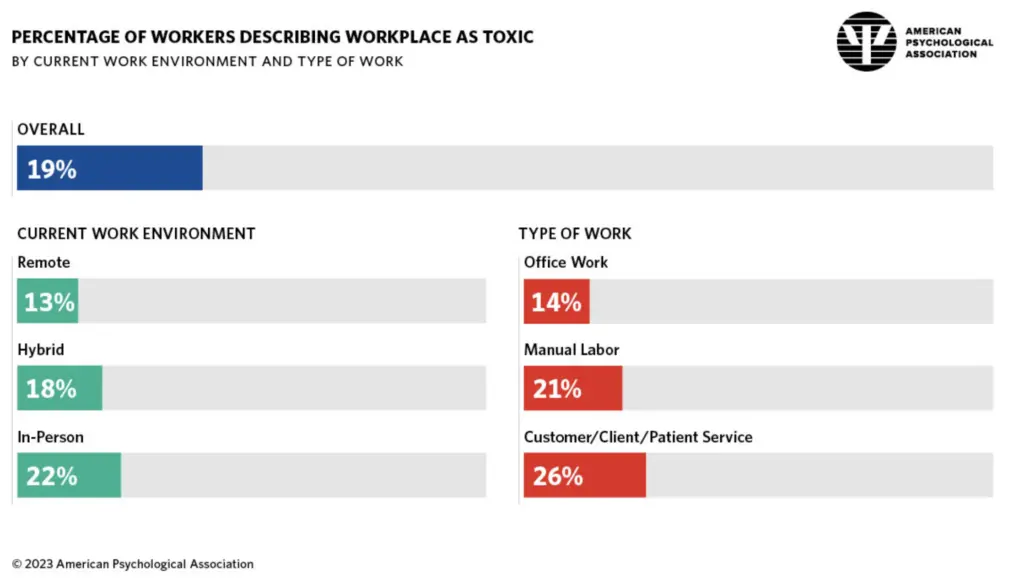Labor market trends can be hard to predict, especially post-COVID, but there’s a common refrain that’s emerged among executives and business owners: “It seems like no one wants to work anymore!”

Actually, the idea that people don’t want to work anymore is far from “new”. There are news clips quoting business owners and labor market researchers dating back 120+ years expressing that same sentiment. So why, then, does now feel different?
Simple: People now have more options. There are far more open positions than people to work them, and that leads directly to higher turnover. In fact, Recruitonomics points out that this is one of the best labor markets for workers in history (one of, but not the best).
While it is true that serial job-hoppers will always exist, many factors feed into why someone might want to leave a company, especially in today’s work environment. And, to be frank, if a business is faced with a swathe of workers all jumping ship at the same time (something known as turnover contagion), maybe it is the company culture that is the problem and not the employees!
Sometimes, the call for change is coming from inside the house!
Employee turnover is a natural — and some might argue, a necessary — part of a business’s annual life cycle. But when it begins to get out of hand, you know that you have a problem. Are you searching for how to reduce employee turnover and boost retention rates? We have some of the answers you might be searching for.
Take It With You
Download our ebook on Why Employees Leave and how mentoring programs increase retention and save companies millions of dollars in turnover costs
What Is Employee Turnover?
Employee turnover is a simple enough concept. When someone leaves their organization for whatever reason, this exit from the organization is considered a “turnover” event. That said, there are two ways of thinking about employee turnover: the colloquial way and the official way, as defined by organizations like the U.S. Bureau of Labor Statistics.
- Colloquially, most of us consider a voluntary quit as the key defining action that constitutes employee turnover. E.g., if Bob puts in his two weeks, we’d consider that turnover, but if Jake is fired, we often don’t consider that to be turnover.
- However, the BLS considers any workplace separation to be a turnover event and calculates these together in its monthly Job Openings and Labor Turnover Survey (JOLTS) report.
Neither is necessarily a right or wrong way of talking about or even calculating turnover. However, from an HR standpoint, it makes sense to distinguish different types of separations, as the implications matter and actions you may or may not need to take will differ.
Firing 10 people in a single day has a different cause and implication than getting 10 resignation letters in a single day. You won’t handle them the same way!
Because it’s far more beneficial to most HR leaders, in this post, we’ll focus on the colloquial definition of employee turnover. So, when we talk about “employee turnover” here, we’re chiefly focused on people who voluntarily quit. The BLS JOLTS data is still valuable, but having a high rate of employees calling it quits is dealt with entirely differently than if you have to let people go. And in many ways, finding a solution to a high quit rate can be far more complicated.
How to calculate your employee turnover rate
The formula to work out your employee turnover rate is quite simple:

In this calculation, the “X%” is your quit rate.
Here’s an illustration of this in practice:
A company starts the year with 120 employees. During that year, 20 employees quit. As the company rounds out the end of the year, there are still 100 employees on the books. The company-wide turnover rate for the year would be 20%.
High turnover affects companies in a multitude of different ways, but almost always comes back to the bottom line revenue and growth for the company. If too many employees quit, it will ultimately impact the organization’s key business goals and financial growth. As we often say within our team, turnover is expensive. The cost to replace an employee can be anywhere from .5X to 2X their salary. And that’s a figure that often doesn’t include the hard-to-calculate impact on team morale and productivity rates.
Turnover Rate Calculator
Enter the following values to calculate the turnover rate:
The impact of turnover on each company will also vary depending on where that turnover is concentrated. High turnover within sales teams, for example, may lead to a sharp drop in new sales growth, while high turnover within an engineering or development team could frustrate existing customers and result in higher customer churn rates.
HR and executive leaders need to account for how each team and individual contributes to the company’s success and growth and what the ultimate financial impact may be if turnover continues to plague certain job functions or departments.
Assess Your Risk!
Download our free Succession Risk Assessment tool to determine which employees or roles need a succession plan
What Causes High Employee Turnover?
You’ll rarely be able to pin turnover on a single factor. The reasons people leave are as dynamic as people themselves. There will always be a host of reasons why employees might think that your company isn’t the right fit for them. Quite often, it’s a “death of a thousand cuts” situation, where the decision to leave is sparked not by a single complaint but by many different, small complaints that build up until that employee feels the need to leave.
Some of the most common reasons why companies can end up with poor employee retention rates include:
- Lack of opportunity: There’s no chance to grow or learn, and little chance to feel fulfilled by tasks.
- Poor management: 57% of respondents to one survey had left at least one role due to a bad boss.
- Better pay and benefits: All companies offer something different, and maybe another business has a more appealing deal.
- Burnout and stress: A stressful working environment will ultimately lead to groups of employees bowing to pressure and needing a break from work.
- No feedback or recognition: It is tough to work without any recognition of your achievements, with one survey finding that 46% of respondents have left a job because they feel unappreciated.
- No longer aligned with company culture: If someone feels like their place of work is moving in a different direction than their morals and personal beliefs, they may wish to find a workplace culture that fits them more closely.
- Poor work-life balance: A FlexJobs survey found that a poor work-life balance was the top reason many people wanted to quit. And yes, forced return-to-office policies have only exacerbated this one.
These are all perfectly valid reasons why someone might want to find a new job. Other factors like health issues or relocation only add to the reasons why someone might decide to move on from a company. However, it is the company’s responsibility to create a positive work environment, so if employees do choose to leave, it is not because of an issue that could be fixed internally.
Why Does a Business Need to Focus on Reducing Employee Turnover?
If you realize that you have employees leaving in swathes, it’s time to consider a few organizational changes. There will always be people coming and going from a business; some might retire after a long and happy service, and others may discover that the company isn’t right for them shortly after joining.
However, if there is a significant need to reduce employee turnover, this will likely also have some knock-on effects for the rest of the company. The negative impact on the company could resemble:
High costs
Recruitment and onboarding are expensive! SHRM reports the average cost per hire is $4,700, so a high turnover rate can quickly begin to add up with each new employee needed! Isn’t there something better that money could be invested in?
If a big portion of a budget is being spent just on recruitment, it could ultimately result in a drop in other areas, such as in career development opportunities. How can employees feel valued if it feels like the priority is being placed on new hires rather than existing workers’ career growth?
A confusing workforce
Your teams end up in chaos. It always seems like someone new is trying to throw in the towel and leave. Information gets lost easily as improper offboarding protocols are set up. Employees reluctantly or even refuse to acknowledge new team members or interim management.
No one wants to talk to one another, and everyone feels like they are out on their own raft and having to fend for themselves. With rampant confusion, how can employees care about the overall goals of the company when they can’t even agree on what they should be as a team?
Client dissatisfaction
All of this chaos can only lead to client or customer dissatisfaction. Deadlines get missed as staff members are shuffled about. Every time the client tries to reach out to have a conversation with the company, they speak to someone new – not because they are being bounced around but because there is someone new in the role!
The client ends up feeling confused and mistrustful of the company, and unless a good relationship can be rebuilt and nurtured, the client could end up taking their business somewhere more stable.
Employee morale
Employee morale always suffers when turnover rates are high. Anyone who decides to stay with the company — for whatever reason — might quickly become demotivated and question whether they made the right decision.

They might be asked to take on responsibilities that are technically not part of their job description and that they have no experience in. With a constant stream of new faces coming in and out, they could also be reluctant to build a connection with other team members, causing the team to be misaligned.
Loss of critical knowledge
When employees leave, the company loses access to all the internal and institutional knowledge that that employee had built up over time. This can be a massive blow to the organization, especially if the employee in question is a specialist in their area.
Without proper succession planning, access to their knowledge will be gone in an instant. There is also no guarantee that someone with the same levels of experience can be recruited before their loss truly hits productivity.
10 Strategies for Reducing Employee Turnover
Any business worried that their employee turnover rate is too high should look to reduce it. Of course, this is much easier said than done. There could be several systematic elements in play that require significant change if you aim to reduce turnover successfully.
This is not going to be an overnight change. As easy as it seems, you can’t flip a switch, make a few key changes, and expect employee engagement and job satisfaction to rise. However, there are some strategies you can deploy to begin to move towards lasting change.
1. Find the right people
Sometimes, you just need to have the right people on your side. You can reduce employee turnover simply by ensuring that you pick the perfect person for the job when you decide to recruit. Though it can sometimes feel like you are hunting down a unicorn, there is someone out there who fits your desired skills, experience, and company culture.
A key part of the recruitment stage will be the interview. Remember, this is not just a chance for you to find out more about the candidate but also an opportunity for them to learn about your company. Anticipate questions and answer them as honestly and clearly as possible.

Creating a false positive image of the business will just result in new employees turning around and heading out the door as quickly as they came in. Recruitment and staffing company Robert Half (a long-time MentorcliQ customer) found that 9 in 10 new hires would leave a job within the first month if that company failed to meet expectations. Businesses set themselves up for failure when they aren’y ready to deliver on employee’s needs.
Actions to implement:
Go into every interview with a plan. Structure and conduct proceedings in a way that removes bias. When asked, be honest about the company. You might not want to highlight the struggles you face, but you also don’t want to create a false impression that will just send the candidate running when they find out the truth. As hiring managers, expect questions like:
- Why is the position open?
- How long did the previous person in this role hold the position, and why did they leave?
- What challenges has the team or department faced recently, and how did it impact this role?
- What can you tell me about the company culture?
2. Create a good onboarding process
When you have found the perfect candidate, you need to make sure their introduction to the business is as smooth as possible. Onboarding is a critical stage in which new employees are introduced to the company at large and given their first experience of both life in the organization and their everyday tasks.
During onboarding, new hires are often required to develop additional hard or soft skills or find a place where they can bridge a gap in the company with their skills. New workers need to feel welcome and supported in this crucial time, and their first taste of the employee experience should set them up for a long tenure at the organization.
Actions to implement:
Ensure that there are clear onboarding objectives to follow and that they feed into a wider employee life cycle plan. Setting up early mentoring and potentially a long-term buddy system can help to create a solid foundation of trust and can be key in ensuring that employee engagement is locked in from Day 1.
3. Stay ahead of industry benchmarks
By actively choosing to stay ahead of other businesses in a given industry, a company can retain employees and potentially attract new talent. Competitive salaries and a good set of benefits can provide rewards and motivation to employees.
Of course, compensation and benefits form just one section of a business’s employee well-being promise. To increase employee retention and become a leader in your given industry, you need to offer employees a complete and competitive package that they actually want.
Actions to implement:
Perform competitor analysis to discover what other organizations are offering. Take a look at your existing collection of benefits and see if a.) any underutilized ones can be cut back or b.) new perks can be introduced. Rather than focus on recruitment, it might also be a better idea to compensate the existing employees more fairly.
4. Recognize employees and reward their efforts
Employees don’t want pizza parties and a pat on the back; they just want their efforts to be recognized and properly rewarded. It really doesn’t take much to offer genuine compliments for a job well done. Employee recognition can work wonders; everyone likes to be told that they are doing a good job!
Actions to implement:
Create a culture of employee recognition and reward that truly respects the value of your employees. Hold team lunches and celebrate employee birthdays and milestone anniversaries. It can even be as simple as including a few lines in a company-wide newsletter or even just a mentor passing on a good word to their mentee. Remember that managers also need support; a thank you to your mentor expresses gratitude and lets them know they are doing a great job, too!
5. Prioritize a healthy work-life balance for your teams
Employee productivity and performance can often be affected by the balance between their home and work lives. If the two are not in harmony, it can result in poor results delivered and an absent-minded employee.
Clear boundaries, such as no contact outside of working hours or during vacation, can help create this clear divide between home and work. This can lead to increased morale and a decreased employee turnover rate.
Actions to implement:
Prioritize employee happiness. Find out what employees need to feel more secure and happier in their existing roles. Focus on creating a robust wellness scheme that meets the needs and expectations of employees.
6. Offer flexible working
White-collar workers got a taste of remote work during the pandemic and most refuse to go back to the status quo. People want to fit their jobs around their lives, not the other way around. Employees increasingly place more value on flexibility as it allows them to focus on their family, spend more time away from their desk, or just get a head start on prioritizing their work-life balance.
96% of U.S. professionals have said that they want flexibility, but only 47% have access to the flexibility that they really need. Flexibility isn’t just about working from home a few days a week; it can also mean the grace to start or finish early as needed.
Actions to implement:
Think about how feasible a flexible work policy might be for your employees. Give them a certain number of hours they have to work each day and trust that they will fulfill them. Not every job has to be a strict 9-to-5. Plus, if the company managed to come out the other side of the pandemic intact, think twice before mandating a return to office, as it might do more harm to your retention than good.
7. Encourage employees to think about growth
While trying to get tasks across the line, it can be easy to forget that employees are also on a journey of professional development. Ideally, no one should leave a role with the same set of skills they had when they got it. Every team member should be encouraged to think about their next steps and where they might wish to go in the future, even if it is not with the same company.
Actions to implement:
Set up a mentoring program and pair like-minded mentors and mentees together. Mentoring can be used to help someone establish where they wish to go in life or to share knowledge and experience within the mentorship. Make sure that there is a budget available for relevant training programs and additional support so employees can increase their skills and knowledge as needed.
8. Remove toxicity
In the 2023 Work in America report from the American Psychological Association, 55% of employees strongly agreed that they felt like their employer thought their workplace was healthier and safer psychologically than it actually was. To reduce employee turnover, a concentrated effort should be made to address toxic behaviors within the company.

Toxic behaviors should not be tolerated in 2024. No one wants to implement lay-offs, but repeat offenders with no intention of changing their actions should quickly find that there is no room for them as the company moves forward.
Actions to implement:
It might seem odd to reduce employee turnover by getting rid of more employees, but removing a bad apple can help improve everyone’s lives. If an organization’s culture allows for the perpetuation of bad behaviors, valuable employees will not want to continue working there, so recognize the disruptive influences and get rid of them.
9. Support employee feedback
Offer employees the opportunity to provide feedback to the company. Performance reviews are not just for passing on feedback to employees; take them as an opportunity to open a two-way dialogue. Management can make countless educated guesses about what employees crave, but that doesn’t mean that they will get it right. They are managers, not mind-readers!
Don’t just encourage employees to give feedback with no intention of doing anything with it. Employees often have good suggestions that can be easily implemented. Even if they suggest something more complex, it could lead to better results for the business once rolled out. Let them shape where they work.
Actions to implement:
Not all employees feel comfortable approaching management with feedback and criticism. A trusted mentor doesn’t just offer direction for professional growth and development, they can also be a necessary ear for collecting feedback.
10. Create a company culture rooted in respect
An organization’s culture really can make all the difference in employee turnover. Establish a culture of respect at all levels of your organization, not only juniors to seniors but also vice versa. Other actions listed above can also feed into a respectful culture, such as listening to feedback and cutting down on toxic behaviors.
Remember, a good company culture is defined by what people think of it. If you want to see an increase in employee retention, you have to create a place where your employees want to work.
Actions to implement:
Peer or group mentoring can be fantastic for establishing and spreading a culture of respect. Everyone builds a relationship with each other and will naturally begin to create a supportive work environment. Be prepared to change and shape a company culture several times as it should grow naturally as the business does.
Reduce employee turnover and boost employee retention with mentoring
When employees feel dissatisfied with their work environment, stuck in their position, and find no pathway forward in their career, they’re far more likely to quit. Mentoring can help reduce the desire or need to quit by improving your company culture and giving employees much-needed personal and professional development. When paired with an algorithm-based matching approach, mentoring is not only far more effective but can help companies see exceptionally high ROI.
This is what Fortune 500 companies like Disney, Robert Half, Principal Financial, Nationwide, and many others have found as a result of running mentoring programs. Not only do MentorcliQ’s customers enjoy an average 32% reduction in turnover, but retention ultimately results in millions of dollars in savings. The “secret sauce”? Leveraging the strength of your own people.
When you build a great culture internally, people want to stay. That starts with helping employees make authentic, person-to-person connections and developing social learning engagements that turnover hard to image.
What’s also hard to imagine is the ease with which you can book a demo. Let us know where your pain points are with turnover, and we’ll let you know exactly how mentoring programs can help.




